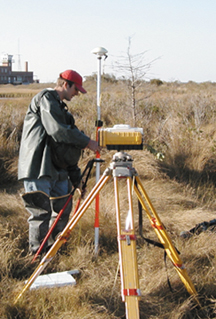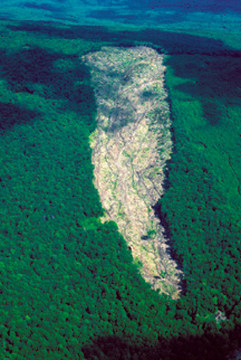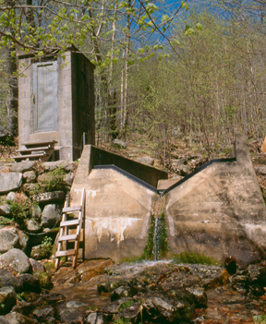 In
1980, the National Science Foundation began a new era in ecological understanding
by establishing the Long Term Ecological Research (LTER) program. The
program’s central mission is to document and analyze ecological processes
that vary over long periods of time and large spatial scales. The program
has grown from an initial five sites with an annual budget of $1.2 million
to a network of 24 ecologically diverse sites throughout the country with
a budget of about $20 million. More than 1,000 participating scientists
and students pull an additional $40 million into LTER-related research
grants.
In
1980, the National Science Foundation began a new era in ecological understanding
by establishing the Long Term Ecological Research (LTER) program. The
program’s central mission is to document and analyze ecological processes
that vary over long periods of time and large spatial scales. The program
has grown from an initial five sites with an annual budget of $1.2 million
to a network of 24 ecologically diverse sites throughout the country with
a budget of about $20 million. More than 1,000 participating scientists
and students pull an additional $40 million into LTER-related research
grants.
In the first decade of LTER research, the sites focused on the same core
ecological processes. The overarching goal was to explain how energy and
nutrients move through plants, soils, groundwater and other parts of the
ecosystem. The research brought together scientists from traditionally
distinct disciplines, such as hydrology, geology and wildlife biology,
as well as ecology.
Phillip Smith, a research
technician, uses GPS to precisely measure the height of a marsh on Hog
Island, part of the Virginia Coast Reserve LTER. Photo by John Porter.
The legacy of multidisciplinary research continues today. However, the
importance of the core areas has faded, replaced by a research agenda
focused on the strengths of individual sites and geared toward informing
sound environmental policies, says Tim Fahey, co-director of the Hubbard
Brook LTER.
Today, global change is the hot topic. Research at many sites aims to
learn how changes in global temperature, sea level and atmospheric chemistry
are, and will, impact local ecology. For instance, the Virginia Coast
Reserve LTER, managed by the University of Virginia, is investigating
whether sea-level rise will drown marshes along the state’s coast.
Marshes connected to barrier islands seem sound. The islands provide sand,
transported by winds and waves, that settles out in the marshes, raising
the marsh plateau faster than increases in sea-level. For marshes in the
nearby lagoons, however, weaker sediment sources and losses of sediment
from the marsh during heavy rains add up to a precariously slow marsh
accretion rate. Results from this study are helping wetland researchers
at other sites along the East Coast hone in on the amounts of sediment
that wash off marshes — a key component to understanding how those
marshes will respond to global change.
Other LTER sites explore how regional ecology affects global atmospheric
conditions. Northern mid-latitude forests appear to be important sinks
for up to 25 percent of the carbon dioxide added to the atmosphere globally
from burning fossil fuels. These forests may provide a buffer against
carbon dioxide-induced climate warming. A tower at the Harvard Forest
LTER in Petersham, Mass., continuously measures the exchange of carbon
dioxide between the forest and the atmosphere. The data show that weather
regulates seasonal variations in how much carbon the forest absorbs. But
the age and composition of the forest largely determine the long-term
carbon budget. Forests that regrow after deforestation take up much more
carbon than mature forests — which may help to explain why forests
in New England, which were largely deforested at the turn of the century
to make way for farming, are currently a carbon sink.
Over the next decade, LTER research should shift toward synthesizing much
of the information gathered at the sites over the past 20 years, according
to an NSF-commissioned panel charged with reviewing past successes and
charting future directions for the program. The goal will be to develop
computer models that simulate the wide breadth of processes studied at
the LTER sites with enough accuracy that they can reliably forecast future
ecological conditions, especially under different management scenarios.
GGP
Back to top

 The first major
project in the forest began in 1965. Hydrologists and ecologists at the U.S. Forest
Service and several universities in New England clear-cut a 39-acre watershed,
leaving not a single tree or shrub standing. Forest managers wanted to explore
the links between forest cover and the quantity and quality of water draining
New England watersheds — especially in relation to spring-time flooding and
the cleanliness of drinking water. “There was only a very rudimentary understanding
of forest hydrology in New England, and in particular upland forest hydrology,”
says Jim Hornbeck, a hydrologist, now retired, who worked for the Forest Service
for 42 years and participated in the original clear-cutting experiment.
The first major
project in the forest began in 1965. Hydrologists and ecologists at the U.S. Forest
Service and several universities in New England clear-cut a 39-acre watershed,
leaving not a single tree or shrub standing. Forest managers wanted to explore
the links between forest cover and the quantity and quality of water draining
New England watersheds — especially in relation to spring-time flooding and
the cleanliness of drinking water. “There was only a very rudimentary understanding
of forest hydrology in New England, and in particular upland forest hydrology,”
says Jim Hornbeck, a hydrologist, now retired, who worked for the Forest Service
for 42 years and participated in the original clear-cutting experiment. The acid rain problem
drives much of the research at Hubbard Brook today. Stream gages at the base of
the watersheds have registered large effluxes of calcium and other important cations
from the forest over the past half century. The greatest losses occurred from
the mid-1950s to the late 1980s, the time of highest sulfur emissions. And while
acid rain certainly contributed to that efflux, researchers do not know exactly
where within the forest ecosystem all the calcium came from, says Joel Blum, a
geochemist at the University of Michigan who has been working at Hubbard Brook
for the past decade.
The acid rain problem
drives much of the research at Hubbard Brook today. Stream gages at the base of
the watersheds have registered large effluxes of calcium and other important cations
from the forest over the past half century. The greatest losses occurred from
the mid-1950s to the late 1980s, the time of highest sulfur emissions. And while
acid rain certainly contributed to that efflux, researchers do not know exactly
where within the forest ecosystem all the calcium came from, says Joel Blum, a
geochemist at the University of Michigan who has been working at Hubbard Brook
for the past decade. 